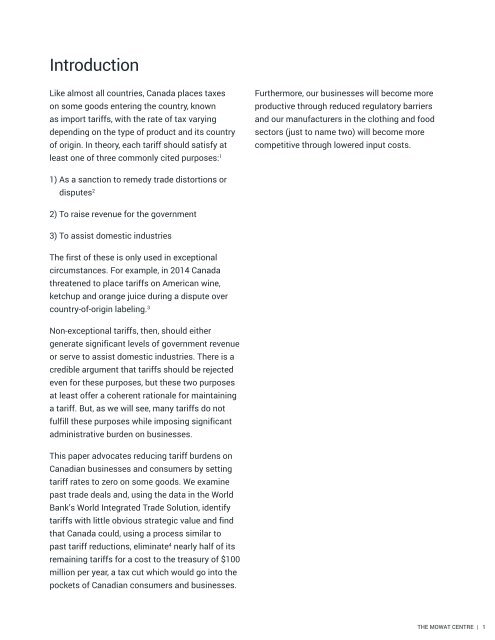Making it Simple
119_making_it_simple
119_making_it_simple
Create successful ePaper yourself
Turn your PDF publications into a flip-book with our unique Google optimized e-Paper software.
Introduction<br />
Like almost all countries, Canada places taxes<br />
on some goods entering the country, known<br />
as import tariffs, w<strong>it</strong>h the rate of tax varying<br />
depending on the type of product and <strong>it</strong>s country<br />
of origin. In theory, each tariff should satisfy at<br />
least one of three commonly c<strong>it</strong>ed purposes: 1<br />
Furthermore, our businesses will become more<br />
productive through reduced regulatory barriers<br />
and our manufacturers in the clothing and food<br />
sectors (just to name two) will become more<br />
compet<strong>it</strong>ive through lowered input costs.<br />
1) As a sanction to remedy trade distortions or<br />
disputes 2<br />
2) To raise revenue for the government<br />
3) To assist domestic industries<br />
The first of these is only used in exceptional<br />
circumstances. For example, in 2014 Canada<br />
threatened to place tariffs on American wine,<br />
ketchup and orange juice during a dispute over<br />
country-of-origin labeling. 3<br />
Non-exceptional tariffs, then, should e<strong>it</strong>her<br />
generate significant levels of government revenue<br />
or serve to assist domestic industries. There is a<br />
credible argument that tariffs should be rejected<br />
even for these purposes, but these two purposes<br />
at least offer a coherent rationale for maintaining<br />
a tariff. But, as we will see, many tariffs do not<br />
fulfill these purposes while imposing significant<br />
administrative burden on businesses.<br />
This paper advocates reducing tariff burdens on<br />
Canadian businesses and consumers by setting<br />
tariff rates to zero on some goods. We examine<br />
past trade deals and, using the data in the World<br />
Bank’s World Integrated Trade Solution, identify<br />
tariffs w<strong>it</strong>h l<strong>it</strong>tle obvious strategic value and find<br />
that Canada could, using a process similar to<br />
past tariff reductions, eliminate 4 nearly half of <strong>it</strong>s<br />
remaining tariffs for a cost to the treasury of $100<br />
million per year, a tax cut which would go into the<br />
pockets of Canadian consumers and businesses.<br />
The Mowat Centre | 1


